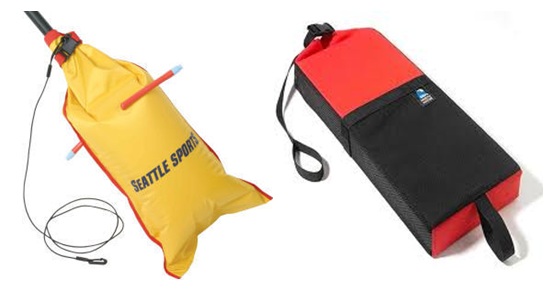It’s unfortunate that so many paddlers fail to appreciate the utility of the critical piece of safety gear. This includes many beginners who have never heard of a paddle float before and so-called “advanced” paddlers who feel as though their skills are beyond needing one. Over the years, I’ve come to appreciate the paddle float as the kayakers version of a Swiss Army knife! Choose the scenario and a paddle float will make at least a reasonable contribution toward a solution. Therefore, the mission of this post is to shed some light on the AMAZING paddle float and why I never leave the dock without two of them on board…
What’s a Paddle Float, Anyway??
The paddle float was intended to be used as a tool to increase the stability of a kayak (or canoe) and aid in re-entry from the water. They’re designed to attach to the paddle blade and increase buoyancy such that the paddle may be utilized as an outrigger for support and stability.
Modern paddle floats come in two flavors: inflatable and foam. Inflatable paddle floats consist of a vinyl “pillowcase-like” sleeve that fits over the paddle blade. Bladders built into either side of the sleeve are manually inflated by blowing into attached tubes. This style of paddle float is highly versatile and packable but takes time to set-up and inflate. I typically take two inflatable paddle floats along on all of my warm-water adventures! Foam paddle floats consist of a solid block of foam with a sleeve that slides over the paddle blade. This style of paddle float is less versatile and packable but best used in cold water situations where taking the time to inflate a paddle float may be deleterious.
The paddle float should be stowed in an assessable location where it can be retrieved by the “swimmer” during a re-entry attempt. I’ve found that the best place is folded under the front bungees (or flat on the back deck if using the foam variety). Some paddlers suggest that you partially inflate the inflatable variety to save time during re-entry.
Why is the Paddle Float so AMAZING??
The paddle float (especially the inflatable style) is an AMAZING piece of gear because of its utility as a re-entry tool and versatility for other uses. Here are some of the things that a paddle float can do:
1) Required Safety Gear
The paddle float should be considered a required piece of paddling safety gear for its utility as a re-entry tool. The paddle float can be used in re-entries such as the: “Paddle Float Re-entry,” “Cowboy Scramble,” and “Re-entry and Roll” to increase stability. Using a paddle float during a solo re-entry will help get you out of the water faster and prevent multiple capsizes. This is especially true in rougher conditions. Remember, practice makes perfect and there’s no substitute for partner rescues when it comes to efficiency and reliability.
Click here to read a great article on the paddle float rescue by Bryan Hansel at paddlinglight.com
2) Increase Stability
A paddle float can increase the stability of your kayak in various situations outside of re-entry, especially when they’re carried in pairs. For example, you can attach a paddle float to either side of your kayak to increase stability in rough water. This technique is also useful to keep a sea-sick paddler upright and prevent the need for a tandem tow. I’ve had to use this a few times to help sea sick paddlers in my group while guiding in Maine and it worked great!
3) Roll Development Tool
I’ve long used paddle floats in my rolling clinics as a development tool to help my students master their hip snap and paddle positions. Inflatable paddle floats are especially useful as you can slowly deflate them to provide less buoyancy as your technique improves. A word of caution: as helpful as paddle floats are they can also lead to the development of some bad habits. Therefore it’s best to use paddle floats sparingly and only in the earliest stages of roll development.
4) Displace Volume
If you’re in a pinch then there’s no reason why an inflatable paddle float couldn’t act as a “float bag” to eliminate un-utilized volume in your kayak. As a rule it’s always a good idea to fill empty space because it will minimize the amount of water that enters your kayak in the event of capsize. Sometimes, when the going looks rough, I’ll inflate a paddle float to take up the space in front of my foot pegs just in case!
5) Increased Comfort
Although this may not be recommended by the manufacturers, I’ve seen paddlers use a partially-inflated paddle float to supplement the paddling on their seats and backrest.
There you have it: The AMAZING Paddle Float! If you don’t carry or own one now then it’s my hope that this post will inspire you to pay a visit to your local paddling shop to buy two!
Happy and Safe Paddling!
-Kayak Dave
Note: “The Amazing Paddle Float” by Dave Arruda (aka Kayak Dave) was first published on Kayaking.org in August 2012




2 Responses to The Amazing Paddle Float: Five Uses from Re-Entry to Comfort